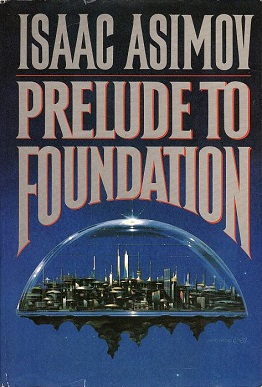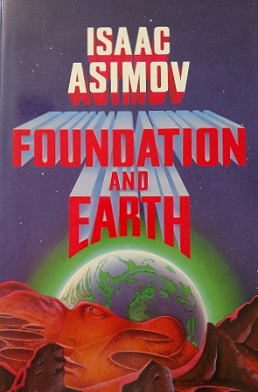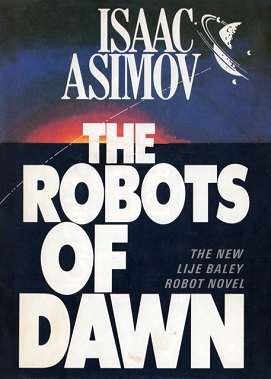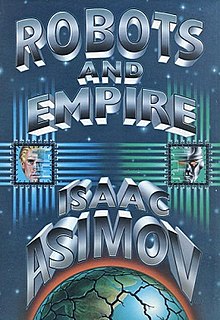
The Caves of Steel is a science fiction novel by American writer Isaac Asimov. It is a detective story and illustrates an idea Asimov advocated, that science fiction can be applied to any literary genre, rather than just being a limited genre in itself.

Prelude to Foundation is a novel by American writer Isaac Asimov, published in 1988. It is one of two prequels to the Foundation series. For the first time, Asimov chronicles the fictional life of Hari Seldon, the man who invented psychohistory and the intellectual hero of the series. The novel was nominated for the Locus Award.

Foundation and Earth is a science fiction novel by American writer Isaac Asimov, the fifth novel of the Foundation series and chronologically the last in the series. It was published in 1986, four years after the first sequel to the Foundation trilogy, which is titled Foundation's Edge.

The Foundation series is a science fiction book series written by American author Isaac Asimov. First published as a series of short stories and novellas in 1942–50, and subsequently in three collections in 1951–53, for nearly thirty years the series was a trilogy: Foundation; Foundation and Empire; and Second Foundation. It won the one-time Hugo Award for "Best All-Time Series" in 1966. Asimov later added new volumes, with two sequels: Foundation's Edge and Foundation and Earth, and two prequels: Prelude to Foundation and Forward the Foundation.

The Robot series is a series of 37 science fiction short stories and six novels by American writer Isaac Asimov, published from 1940 to 1995. The series is set in a world where sentient positronic robots serve a number of purposes in society. To ensure their loyalty, the Three Laws of Robotics are programmed into these robots, with the intent of preventing them from ever becoming a danger to humanity. Later, Asimov would merge the Robot series with his Foundation series.
The Galactic Empire series is a science fiction sequence of three of Isaac Asimov's earliest novels, and extended by one short story. They are connected by their early place in his published works and chronological placement within his overarching Foundation universe, set around the rise of Asimov's Galactic Empire, between the Robot and Foundation series to which they were linked in Asimov's later novels.

The Three Laws of Robotics are a set of rules devised by science fiction author Isaac Asimov. The rules were introduced in his 1942 short story "Runaround", although similar restrictions had been implied earlier stories. The Three Laws, supposedly from the "Handbook of Robotics, 56th Edition, 2058 A.D.", are:

Nemesis is a science fiction novel by American writer Isaac Asimov. One of his later science fiction novels, it was published in 1989, three years before his death. The novel is loosely related to the future history of his Robot Series, Empire Series, and Foundation Series, into which Asimov attempted to integrate his science fiction output. This novel is connected to Asimov's other works by several ideas from earlier and later novels, including non-human intelligence, sentient astronomical bodies ("Hallucination"), and rotor engines.

Pebble in the Sky is a science fiction novel by American writer Isaac Asimov, published in 1950. This work is his first novel — parts of the Foundation series had appeared from 1942 onwards in magazines, but Foundation was not published in book form until 1951. The original Foundation books are also a string of linked episodes, whereas this is a complete story involving a single group of characters.
A positronic brain is a fictional technological device, originally conceived by science fiction writer Isaac Asimov. It functions as a central processing unit (CPU) for robots, and, in some unspecified way, provides them with a form of consciousness recognizable to humans. When Asimov wrote his first robot stories in 1939 and 1940, the positron was a newly discovered particle, and so the buzz word "positronic" added a scientific connotation to the concept. Asimov's 1942 short story "Runaround" elaborates his fictional Three Laws of Robotics, which are ingrained in the positronic brains of nearly all of his robots.

R. Daneel Olivaw is a fictional robot created by Isaac Asimov. The "R" initial in his name stands for "Robot," a naming convention in Asimov's future society during Earth's early period of space colonization. Daneel is introduced in The Caves of Steel, a serialized story published in Galaxy magazine vol. 7 #1-3 from October to December 1953. The full story was published by Doubleday as a hardcover book in 1954.

The Naked Sun is a science fiction novel by American writer Isaac Asimov, the second in his Robot series. Like its predecessor, The Caves of Steel, this is a whodunit story. It was first published in book form in 1957 after being serialized in Astounding Science Fiction between October and December 1956.

The Robots of Dawn is a "whodunit" science fiction novel by American writer Isaac Asimov, first published in 1983. It is the third novel in Asimov's Robot series.

Elijah "Lije" Baley is a fictional character in Isaac Asimov's Robot series. He is the main character of the novels The Caves of Steel, The Naked Sun and The Robots of Dawn, and of the short story "Mirror Image." He is seen in flashbacks several times and talked about frequently in Robots and Empire, which is set roughly 160 years after his death. He is further mentioned in passing in "Foundation and Earth" as a "Culture Hero". Besides Asimov's works he appears in the Foundation's Friends story "Strip-Runner" by Pamela Sargent, and "Isaac Asimov's 'The Caves of Steel'" poem by Randall Garrett.

Foundation and Chaos (1998) is a science fiction novel by Greg Bear, set in Isaac Asimov's Foundation universe. It is the second book of the Second Foundation trilogy, which was written after Asimov's death by three authors, authorized by the Asimov estate.

Foundation's Triumph (1999) is a science fiction novel by American writer David Brin, set in Isaac Asimov's Foundation universe. It is the third book of the Second Foundation trilogy, which was written after Asimov's death by three authors, authorized by the Asimov estate. Brin synthesizes dozens of Foundation-Empire-Robots novels and short stories by Isaac Asimov, Roger MacBride Allen, and authorized others into a consistent framework. Foundation's Triumph includes an appendix chronology compiled by Attila Torkos.
"Mirror Image" is a science fiction short story by American writer Isaac Asimov, originally published in the May 1972 issue Analog Science Fiction and Fact, and collected in The Best of Isaac Asimov (1973), The Complete Robot (1982), Robot Visions (1990), and The Complete Stories, Volume 2 (1992).
Robots is a 1988 Interactive movie directed by Doug Smith and Kim Takal. Its screenplay, by Peter Olatka, is based on Isaac Asimov's Robot series. It stars Stephen Rowe as Elijah Baley, Brent Barrett as R. Daneel Olivaw, and John Henry Cox as Han Fastolfe.
The Foundation universe is the future history of humanity's colonisation of the galaxy, spanning nearly 25,000 years, created through the gradual fusion of the Robot, Galactic Empire, and Foundation book series written by American author Isaac Asimov.












